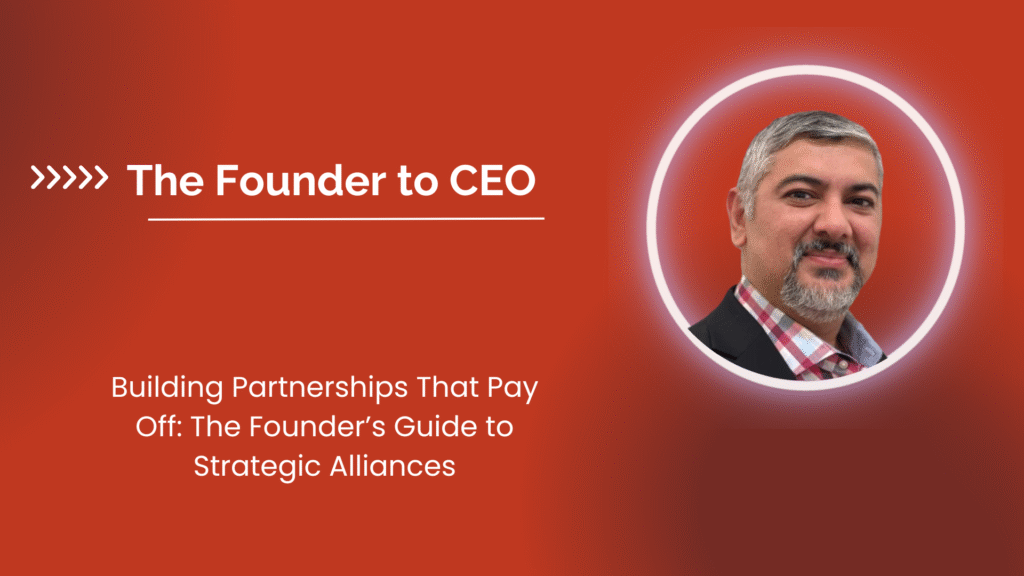Ever tried to build your business entirely on your own? It’s like rowing a boat with one oar. You might move but you’ll just go in circles.
No business scales solo. The most successful founders, even those who break through plateaus, build partnership engines. Not surface-level collaborations, but deep alliances that multiply reach, reduce risk, and create compounding momentum.
Let’s unpack how to build partnerships that actually pay off.
Step 1: Start With Self-Awareness, Not Strategy
Every founder wants partnerships to “drive growth.” But few pause to ask, what kind of growth am I built for?
However, not every partnership is right for your stage or DNA.
- Bootstrapped? You need lean, revenue-sharing collaborations that move fast.
- Funded? You can afford brand-aligned alliances that compound long-term.
- Platform-stage? You’re ready for ecosystem plays, joint products, integrations, shared customers.
Action Step:
Before chasing a deal, define your partnership archetype.
Ask:
- Does this expand distribution, credibility, or capability?
- Will it create leverage or just another dependency?
You can’t build powerful partnerships from a weak center.
Step 2: Seek Complementary Strengths, Not Clones
Most founders make the rookie mistake of partnering with people just like them. Same market. Same skillset. Same blind spots.
Partnerships thrive on contrast not similarity.
Think Jobs and Wozniak. One visionary. One engineer.
Or Nike and Apple: athletic meets tech.
The synergy isn’t in sameness; it’s in alignment of difference.
Action Step:
Make a list of your core assets like audience, product, expertise, capital, credibility and find partners who complete the missing piece.
Ask:
- Who already serves my customer before or after me?
- Who wins when I win?
That’s where the magic lives.
Step 3: Build Trust Before the Transaction
Partnerships die in the first three months not because of bad terms but because of bad trust.
You can’t negotiate your way into loyalty. It’s earned through early wins.
Start small. Collaborate on a webinar, a pilot, or a co-marketing campaign before signing a full-blown deal.
Let trust compound through results.
Action Step:
Set a “90-Day Prove It” rule.
Before any official agreement, test chemistry through a small, measurable project.
If it flows easily, scale it.
If it drags, walk away.
Partnerships are like dating. If it’s exhausting early on, it probably won’t get better with time.
Step 4: Create Mutual Math
Great partnerships are mutually profitable.
When one side feels shortchanged, resentment brews.
When both win clearly, the alliance grows organically.
This is where most founders go wrong. They think in percentages instead of value exchange.
Don’t just split revenue. Quantify what each side truly brings:
- Distribution?
- Technology?
- Content?
- Credibility?
- Support?
Then design the deal so both sides’ inputs are rewarded proportionately.
Pro Tip:
Always put the win on the customer’s side first. The fastest way to build lasting partnerships? Make sure your customers benefit most.
When they win, everyone wins.
Step 5: Systematize the Relationship
You can’t scale what you can’t repeat.
Most founders treat partnerships like one-off events, a handshake deal or Slack chat at best. But the best companies turn partnerships into a system.
They track joint metrics (leads, conversions, retention).
They host quarterly reviews.
They may even go so far as OKRs.
They treat partners like strategic business units not side hustles.
Action Step:
Build a “Partner Operating System.”
Include:
- Shared success metrics
- Clear communication cadence
- Joint content or marketing calendar
- Decision-making rules (Who approves what, and when?)
Partnerships without structure become partnerships without success.
Step 6: Protect the Relationship Like It’s Equity
Once a partnership starts paying off, protect it like you would your best customer.
That means clarity in contracts. Transparency in communication. And shared credit when things go right.
The fastest way to kill momentum? Get territorial.
When ego enters, synergy exits.
Action Step:
Establish a Partnership Bill of Rights:
- Mutual respect for brand integrity
- Shared wins in public
- Dispute resolution path
- Non-compete boundaries
It’s not about bureaucracy, it’s about preserving what works.
Step 7: Know When to End It
Not every partnership is meant to last forever.
Some are meant to open doors. Some are meant to teach lessons. Some expire after their value is fully realized.
The worst mistake you can make? Holding onto a dead partnership out of loyalty.
Action Step:
Review every key partnership quarterly. Ask:
- Is this still creating leverage?
- Are both sides still invested?
- Is this moving us toward our North Star or sideways?
If not, end it gracefully. Always leave the door open.
Because relationships compound, even when deals don’t.
The Mindset Shift
Partnerships aren’t just a growth strategy; they’re a leadership test.
They reveal how well you align interests, manage expectations, and build trust across boundaries.
When done right, they become your secret weapon, a network effect that accelerates every other part of your business.
The founders who master partnerships don’t just build companies. They build ecosystems.
So ask yourself:
Who can I grow with, not just grow from?


